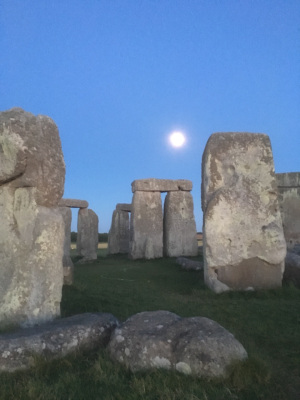In a new study, archeologists have proposed the claim that Stonehenge and other ancient stone monuments were probably used for special moonlit ceremonies which would have taken place deep in the night. These Neolithic structures have always been thought to have been used primarily in the daytime, as the rocks at various stone monuments are meant to align with the sun, one example of which would be Stonehenge lining up in perfect fashion for the yearly Summer Solstice. (Inquisitr)
- An analysis of Hendraburnick Quoit in Cornwall revealed multiple carvings visible in moonlight or low sunlight – suggesting the stone was viewed at night
- Archaeologists Dr Andy Jones of the Cornwall Archaeological Unit and Thomas Goskar found a total of 105 engravings on the axe-shaped stone
- Dr Jones believes many more markings would be found at sites across the country if the monuments were looked at in a different light
However, fresh evidence now shows that Stonehenge and other ancient stone

Druids celebrating the Winter Solstice at Stonehenge.
monuments were also very likely to have been used at night for moonlit ceremonies. Dr. Andy Jones, who has been studying the Hendraburnick Quoit in Cornwall, has found that at this particular site, you can see at least 10 times as many markings on the engraved panel when viewed directly under the moonlight.
Archaeologists have also discovered that at some point, people smashed up many pieces of quartz around the area which would have glowed in the dark and created a very unique effect at night. Dr. Andy Jones has been working in conjunction with the Cornwall Archaeological Unit and believes that this phenomenon is probably not limited to the Hendraburnick Quoit, but can also be found at other ancient stone monuments such as Stonehenge, as The Telegraph reported.
“I think the new marks show that this site was used at night and it is likely that other megalithic sites were as well.”
After noticing some very specific markings on the stones that had never been seen before, Dr. Jones explained that the archaeological team then went out at night to photograph the ancient stone monument and discovered even more art which was only truly visible at night and beneath the moon.
“We were aware there were some cup and ring marks on the rocks but we were there on a sunny afternoon and noticed it was casting shadows on others which nobody had seen before. When we went out to some imaging at night, when the camera flashed we suddenly saw more and more art, which suggested that it was meant to be seen at night and in the moonlight.”
With the ancient quartz that is smashed all around the site, this would have created an eerily surreal atmosphere at night next to these ancient Neolithic stone monuments and would have lent magic to whatever nighttime ceremonies were performed at these locations. It is known that Stonehenge also has unusual markings which can only be seen at night, and archaeologists believe that many other stone monuments do as well.
“Then when you think about the quartz smashed around, which would have caused flashes and luminescence, suddenly you see that these images would have emerged out of the dark. Stonehenge does have markings, and I think that many more would be found at sites across the country if people were to look at them in different light.”
At the Hendraburnick Quoit in Cornwall, there had originally been 13 markings detected on the stone, but Dr. Andy Jones and his colleague Thomas Goskar discovered that there were actually 105 markings here when viewed under different light. Archaeologists now believe that it is extremely likely that nighttime ceremonies were conducted at ancient stone sites like this as the night was associated with the supernatural. Individuals involved in these ceremonies may have smashed the stones to release very special luminescent properties from them, which would explain the many pieces of quartz that have been found at ancient stone monuments like this.
“After the ritual, the broken pieces, once they had fallen on the ground, could have effectively formed a wider platform or arc which would have continued to glisten around it in the moonlight, and thereby added to the aura of the site.”
While Stonehenge and other ancient stone monuments are usually only studied by day, archaeologists will now be trying to discover what may have taken place during these special ceremonies that would have been conducted at night by way of moonlight.
Source: Inquistir
Related Stonehenge Links:
Cornish stone monuments have carvings that are only visible in moonlight, investigation reveals Daily Mail
Astro Moon Calendar shows phases of the Moon each day, astronomical events and astrological forecast for the year.
Stonehenge and Ancient Astronomy. Stonehenge and Avebury World Heritage Site
Stonehenge Full Moon Guided Walking Tours. Explore the landscape with a local historian and astronomer.
The Stonehenge News Blog
Follow us on Twitter and Facebook for daily Stonehenge sunset / sunrise / moonrise / moonset times.














Reblogged this on Stonehenge Guided Trips.